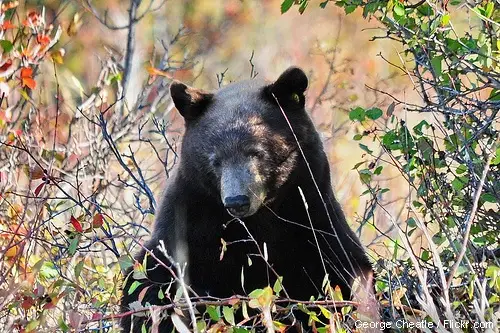On a quiet autumn morning, nestled deep within the scenic valley of Evergreen Pines, the townsfolk were going about their daily routines. The air was crisp, and golden leaves rustled gently along the streets as the town’s bakery filled the air with the scent of fresh bread. Nothing seemed out of the ordinary—until a heart-wrenching sight unfolded on Main Street.
A large black bear, wounded and weary, limped into the town. His massive body was covered in dirt, his fur matted and torn, and his left hind leg dragged painfully behind him. It was clear he had been suffering for days. His dark eyes, clouded with exhaustion, seemed to plead for mercy. A hush fell over the town as people stopped in their tracks to watch the tragic figure slowly make his way down the street. The bear, unable to carry himself any further, collapsed in the middle of the road.
A Moment of Fear and Compassion
At first, fear gripped the townspeople. A wild animal in such a condition could be dangerous. Parents grabbed their children, shopkeepers peered out from behind their counters, and the local sheriff instinctively placed a hand on his firearm. But something about the bear’s demeanor was different. He wasn’t here to attack—he was too weak to do so even if he wanted to. The sight of this once-mighty creature now lying helplessly stirred something in the hearts of those who watched.
Then, something remarkable happened. An elderly woman, known to the town as Grandma Eleanor, stepped forward. Eleanor, a retired wildlife rehabilitator, had spent much of her life tending to injured animals. Her movements were slow but deliberate as she walked toward the bear, undeterred by the worried murmurs around her.
An Act of Courage
“Stay back, Eleanor!” the sheriff called out. “It could be dangerous!”
But Eleanor simply raised a hand to silence him. “He’s in pain,” she said softly. “Look at him. He’s not here to hurt anyone. He’s looking for help.”
She knelt down just a few feet away from the bear. His labored breathing was evident, his body trembling from exhaustion. Carefully, she reached into the satchel she always carried and pulled out a water bottle. She unscrewed the cap and slowly poured a little into a small tin bowl she had brought with her.
The bear sniffed the air, his ears flicking forward. His instincts told him to be cautious, but thirst overpowered fear. With great effort, he dragged himself forward slightly and lapped at the water. The entire town watched in awe as the scene unfolded.
A Community Rallies Together
Inspired by Eleanor’s courage, others began to step forward. The local veterinarian, Dr. Adams, quickly gathered supplies, bringing antiseptics and bandages. A group of strong young men carefully lifted the bear onto a makeshift stretcher crafted from wooden planks and blankets. With a coordinated effort, they transported him to an open space behind the town’s clinic where he could be treated.
Dr. Adams assessed the injuries. The bear had a deep gash on his side, possibly from a fight or a hunter’s stray bullet. His hind leg was broken—most likely hit by a vehicle while he tried to cross a road in the nearby forest. His body was weak from malnutrition, dehydration, and infection.
“We’ll need to keep him stable,” Dr. Adams declared. “We can’t let him suffer.”
The townspeople didn’t hesitate. They gathered food—fresh fish, berries, and even some honey—setting up a safe space where the bear could rest and recover. Eleanor stayed by his side, gently stroking his fur as she hummed old lullabies. The bear, though in pain, seemed to find solace in her presence.
A Slow But Miraculous Recovery
Days turned into weeks, and the black bear, whom the townspeople affectionately named “Bruno,” showed signs of improvement. His wounds began to heal, his strength gradually returned, and the once-dull gleam in his eyes came back to life.
Throughout his recovery, the town ensured that he remained comfortable. Children would visit, drawing pictures of him and leaving small treats near his enclosure. The local carpenter even built a sturdy wooden shelter to protect him from the cold.
Bruno, in return, showed his gratitude in small but touching ways. He would softly grunt in recognition whenever Eleanor approached, nudging her gently with his nose. He never displayed aggression, seeming to understand that these people had saved his life.
The Day of Farewell
After two months of care, Bruno was strong enough to return to the wild. On a crisp December morning, the townsfolk gathered to bid him farewell. The town’s gates were opened, leading to the vast, snow-dusted forests beyond. Eleanor stood beside him, one hand resting on his massive shoulder.
“You’re ready now, old friend,” she whispered. “Go live as you were meant to.”
Bruno looked around, his dark eyes scanning the faces of those who had saved him. Then, with one last huff, he turned and lumbered toward the trees. The town watched in silence as he disappeared into the wilderness, knowing they had done something extraordinary.
A Legacy of Kindness
The story of Bruno became legend in Evergreen Pines. Visitors from far and wide came to hear about the town that had saved a dying bear. The town’s children grew up telling the tale, and a small plaque was placed at the entrance of the forest, reading:
“In memory of Bruno, the bear who reminded us that compassion knows no bounds.”
Bruno never forgot the kindness he had received. Occasionally, glimpses of a large black bear were reported near the town’s outskirts, always keeping his distance but watching, as if ensuring that those who had once saved him were safe in return.

